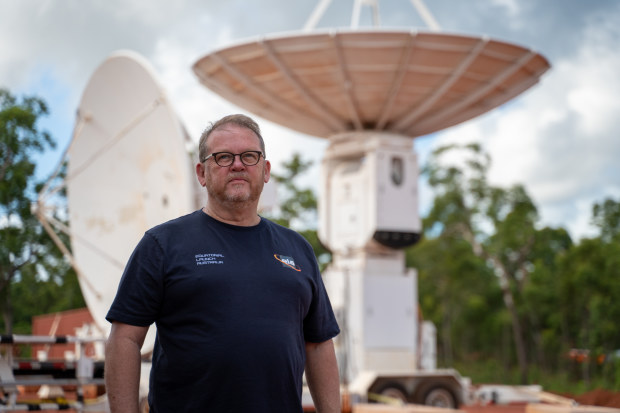The start-up launching rockets for NASA from Arnhem Land

Australia will host a NASA rocket launch for the first time in three decades, but this time a private company – not the government – will be running the mission control centre.
If all goes to plan, the launch will be conducted by a start-up called Equatorial Launch Australia, which owns and operates the Arnhem Space Centre in the Northern Territory, at 10.44 pm on Sunday.

Michael Jones, executive chairman and group chief executive of Equatorial Launch Australia, is preparing for a final rehearsal ahead of Sunday’s rocket launch.
It’s a feat that Michael Jones, the executive chairman and group chief executive of ELA, did not believe could be achieved when he was approached about the idea seven years ago.
“When Scott [Wallis, the founder of ELA] approached me to get involved I said ‘mate, you’re dreaming. There’s no appetite or capability or market reason why we would have a space industry here in Australia’. I have been proven absolutely wrong on that.”
ELA is one of a handful of launch companies that have sprung up in Australia. Others are Gold Coast-based Gilmour Space and South Australia’s Southern Launch, which had three failed launch attempts in 2021.
Countdown
About 80 NASA personnel have travelled to the ELA launch site, which is located on the Dhupuma Plateau near Nhulunbuy, on the lands of the Gumatj people (who have leased the land to ELA).

ELA will conduct three launches for NASA over the next month, which will be the first since 1995, when launches were conducted from the Royal Australian Air Force Woomera range complex.
Security has been tightened around the space centre and on Saturday the teams will complete a final six-hour rehearsal for the launch.
“There’s no exhilaration or excitement yet, everyone is too busy,” Mr Jones said.
The first rocket will travel to over 300km in space and will carry an atmospheric observation and sensing platform to study the Alpha Centauri A and B constellations. NASA wants to conduct astrophysics studies that can only be done from the southern hemisphere.
The rockets will be visible to the local community and surrounding areas for seconds after lift-off – about 150 metres into the sky until just before exiting the earth’s atmosphere.
An inflection point
James Brown, the chief executive of the Space Industry Association of Australia, said the launch was a sign that the nation’s space industry was maturing after battling with bureaucrats to allow private companies to participate in the sector.
“The legislation we had was set up in a time when going to space looked like the Apollo 11 mission, not for private companies with small rockets,” Mr Brown said.
He said the Australian Space Agency, which was established in 2018, had overhauled the law and given private investors the confidence to back space start-ups.
“We’re clearly at an inflection point for the space industry. We’re seeing large investments by government and by private investors as well.”
The ink has only just dried on the paperwork, allowing ELA to launch.
ELA was awarded its launch facilities licence and the launch permit for the NASA campaign following a two-year evaluation by the Australian Space Agency. The final approval was delayed by the election, with Deputy Prime Minister Richard Marles signing off on the plan shortly after being sworn in.
Launch business
Despite landing NASA, the world’s oldest and most experienced space agency, as its first client in 2019, it hasn’t always been smooth sailing for ELA, which ran into financial trouble in 2020 that led to a new management team taking over the business and shaking up its strategy and structure.
Mr Jones, who founded the airline Regional Express, was previously an adviser to the business and took on an operational role in June 2021.
“NASA has shown unbelievable perseverance and patience with ELA, and it’s only really in the last eight or nine months that we’ve really hit our straps and been on schedule on budget, delivering what we are meant to,” Mr Jones said.

The Arnhem Space Centre is on the Gove Peninsula in the Northern Territory.
ELA has raised more than $20 million from investors, including the Northern Territory government which owns less than 5 per cent of the business.
Since the company launched in 2015 it has not received any government grants, Mr Jones said.
“We’ve never been given a grant. It’s all been done through private equity investment based on selling the dream initially and then what, we believe, is a pretty robust business plan,” he said.
The business has plans to raise a further $50 million to reach “self-sustainable profitability and a potential IPO down the track”.
Once the infrastructure for the Arnhem Space Centre is built, the launch fees from its customers will fund the operations of the business, Mr Jones said.
He said the company is in discussions with nine other major rocket companies, and it hopes to carry out at least two additional launches in 2022 before ramping up to 50 launches per year by 2025.
“The ASC offers Australian space businesses and international rocket and satellite companies a unique opportunity to launch from a site which provides cost-effective access to virtually any orbit they desire,” Mr Jones said.
Subscribe to gift this article
Gift 5 articles to anyone you choose each month when you subscribe.
Subscribe nowAlready a subscriber?
Introducing your Newsfeed
Follow the topics, people and companies that matter to you.
Find out moreRead More
Latest In Technology
Fetching latest articles